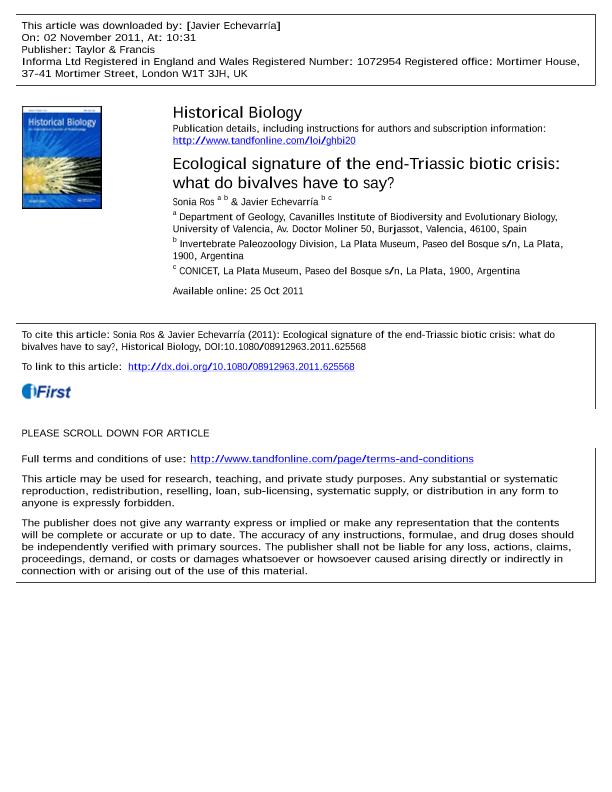Mostrar el registro sencillo del ítem
dc.contributor.author
Ros, Sonia
dc.contributor.author
Echevarría, Javier

dc.date.available
2023-04-14T18:11:01Z
dc.date.issued
2012-10
dc.identifier.citation
Ros, Sonia; Echevarría, Javier; Ecological signature of the end-Triassic biotic crisis: What do bivalves have to say?; Taylor & Francis; Historical Biology; 24; 5; 10-2012; 489-503
dc.identifier.issn
1029-2381
dc.identifier.uri
http://hdl.handle.net/11336/193949
dc.description.abstract
In order to understand the causes underlying the Triassic-Jurassic (T/J) mass extinction, we tested different bivalve features for extinction selectivity, i.e. shell mineralogy, age at the Rhaetian and three main autoecologic traits (feeding mechanism, tiering and motility/attachment). Also, diversity and turnover rates throughout the Triassic and the Early Jurassic were analysed in detail. The dataset employed for this analysis was a precise database at genus level including data from Induan to Sinemurian times. Results point to a true mass extinction for bivalves around the T/J boundary. This extinction was not age-selective at the boundary. Certain analyses suggested that shell mineralogy was a character significantly increasing survival odds, but this relationship seems to reflect selectivity on autoecologic traits. There was no difference in extinction proportions between both feeding types (i.e. deposit feeders and filter feeders); among the other traits, deep burrowers, epifaunal-motile and endobyssate forms seem to have been favoured, while shallow burrowers (and probably reclined forms) were more heavily affected. This pattern suggests an environmental stress at the boundary with some particular issues affecting the different life modes. Models linking magmatism in the Central Atlantic Magmatic Province with the end-Triassic mass extinction are a plausible scenario for this kind of perturbation.
dc.format
application/pdf
dc.language.iso
eng
dc.publisher
Taylor & Francis

dc.rights
info:eu-repo/semantics/openAccess
dc.rights.uri
https://creativecommons.org/licenses/by-nc-sa/2.5/ar/
dc.subject
AUTOECOLOGY
dc.subject
BIVALVIA
dc.subject
CAMP
dc.subject
END-TRIASSIC EXTINCTION
dc.subject
SELECTIVITY
dc.subject
SHELL-MINERALOGY
dc.subject.classification
Paleontología

dc.subject.classification
Ciencias de la Tierra y relacionadas con el Medio Ambiente

dc.subject.classification
CIENCIAS NATURALES Y EXACTAS

dc.title
Ecological signature of the end-Triassic biotic crisis: What do bivalves have to say?
dc.type
info:eu-repo/semantics/article
dc.type
info:ar-repo/semantics/artículo
dc.type
info:eu-repo/semantics/publishedVersion
dc.date.updated
2023-04-10T10:11:18Z
dc.journal.volume
24
dc.journal.number
5
dc.journal.pagination
489-503
dc.journal.pais
Reino Unido

dc.journal.ciudad
Londres
dc.description.fil
Fil: Ros, Sonia. Universidad Nacional de La Plata. Facultad de Ciencias Naturales y Museo. División Paleozoología Invertebrados; Argentina. Universidad de Valencia; España
dc.description.fil
Fil: Echevarría, Javier. Universidad Nacional de La Plata. Facultad de Ciencias Naturales y Museo. División Paleozoología Invertebrados; Argentina. Consejo Nacional de Investigaciones Científicas y Técnicas. Centro Científico Tecnológico Conicet - La Plata; Argentina
dc.journal.title
Historical Biology
dc.relation.alternativeid
info:eu-repo/semantics/altIdentifier/url/http://www.tandfonline.com/doi/abs/10.1080/08912963.2011.625568
dc.relation.alternativeid
info:eu-repo/semantics/altIdentifier/doi/http://dx.doi.org/10.1080/08912963.2011.625568
Archivos asociados
